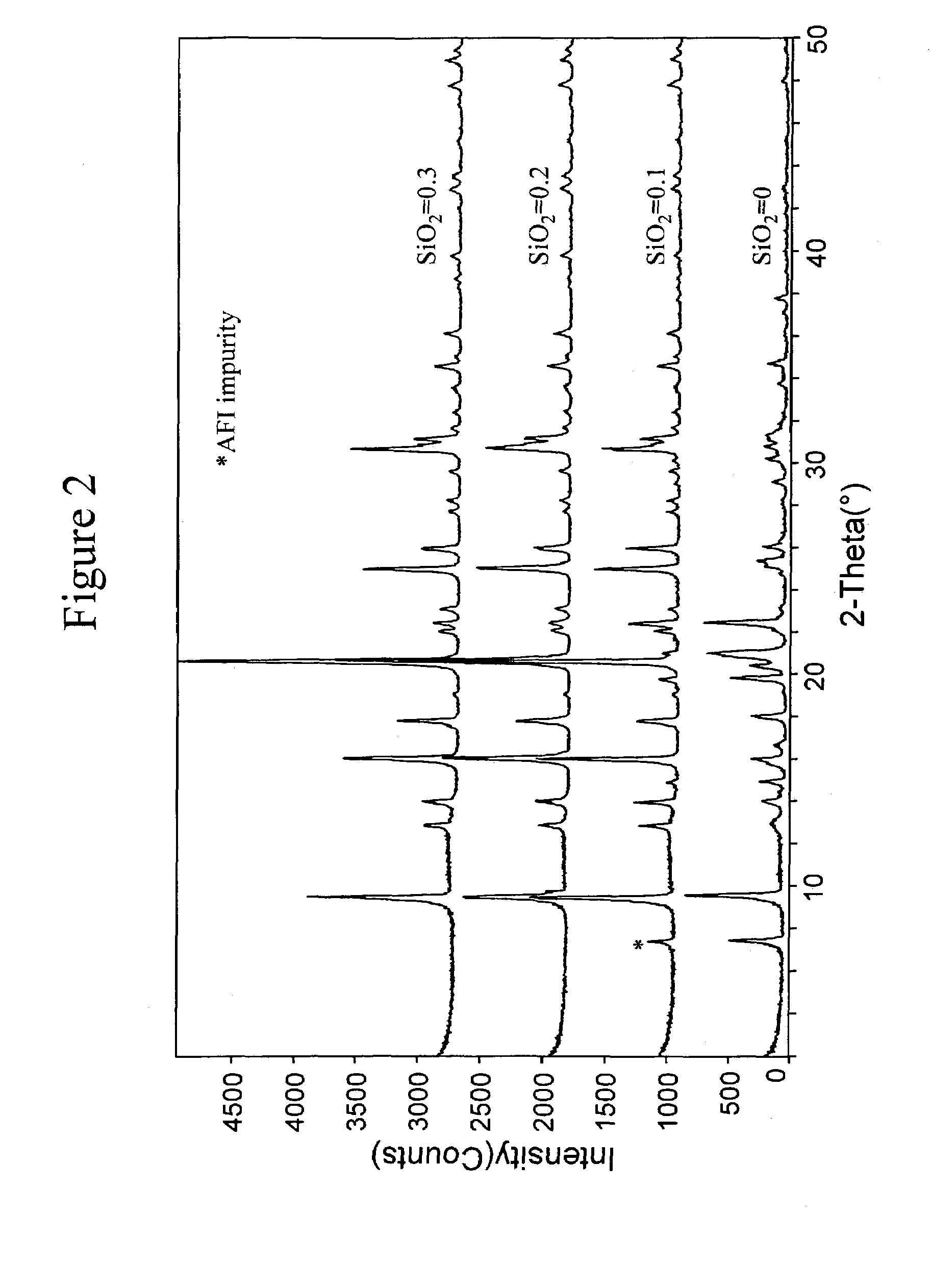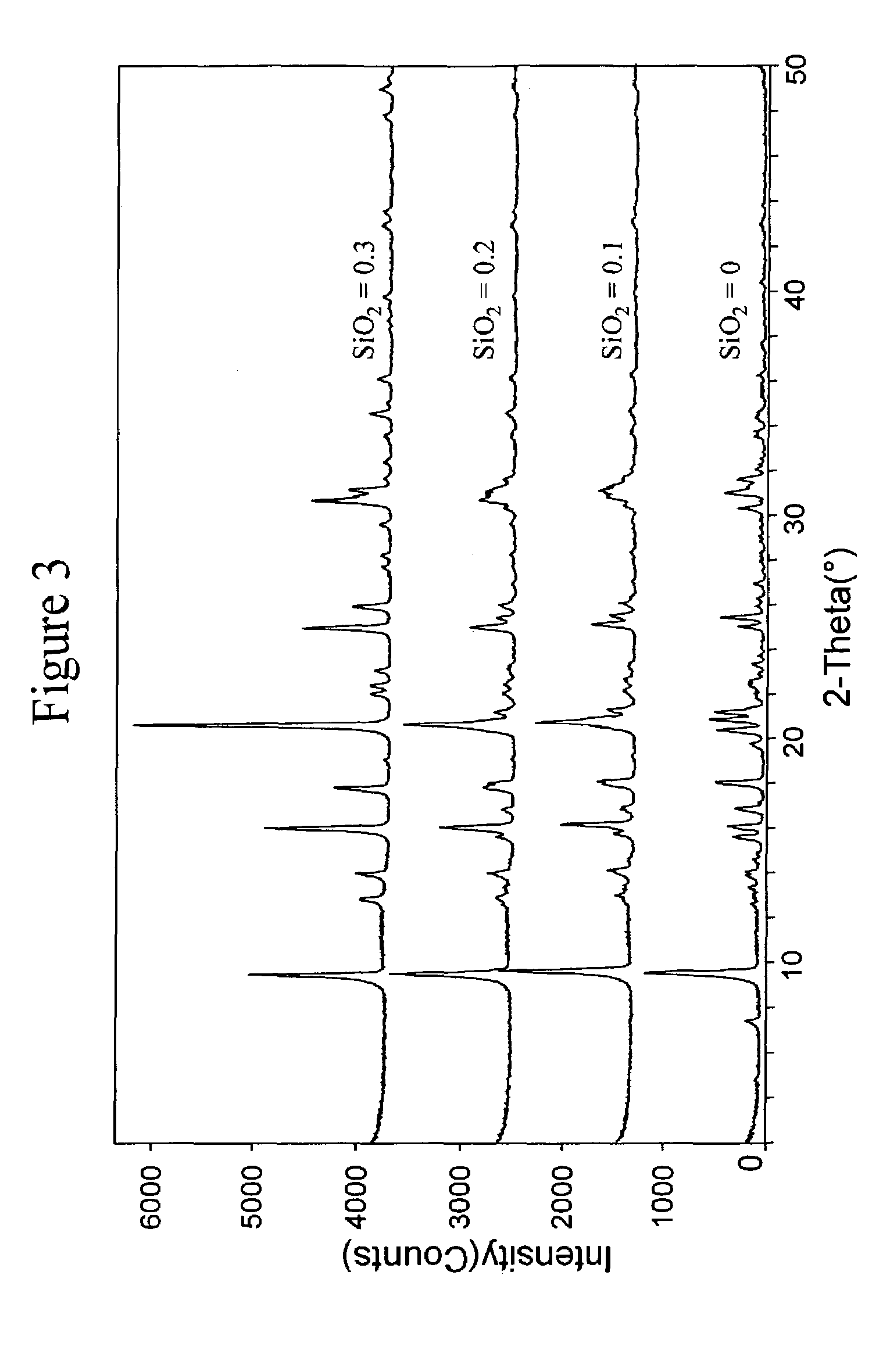Synthesis of aluminophosphates and silicoaluminophosphates
a technology which is applied in the field of synthesis of silicoaluminophosphate and aluminophosphate molecular sieve, can solve the problems of limited range of synthesis parameters of teaoh and dpa, complicated process of sapo molecular sieve synthesis,
- Summary
- Abstract
- Description
- Claims
- Application Information
AI Technical Summary
Benefits of technology
Problems solved by technology
Method used
Image
Examples
example 1
[0117]Eight samples were prepared and characterized by the procedures described below.
[0118]The following ingredients were mixed, in sequence, and blended into a uniform gel using a microhomogenizer (Tissue Tearor Model 98730 available from Biospec Products, Inc, USA): 85 wt % H3PO4 (obtained from Aldrich Chemical Company), H2O, Cabosil™ (available from Cabot Corporation, Illinois, USA), Catapal™ A (74 wt % Al2O3, available from CONDEA Vista Company, Texas, USA), and then N,N-dimethylcyclohexylamine (DMCHA; (CH3)2NC6H11; obtained from Aldrich Chemical Company, USA). The molar ratio of the ingredients was as follows:
2.0 DMCHA:1.0 A2O3:x SiO2:1.0 P2O5:40 H2O x=0,0.1,0.2 and 0.3
[0119]In the case where x=0.1, 14.58 g deionized water was first added to 5.65 g H3PO4. Then 3.38 g Catapal™ A, 0.16 g Cabosil™ and 6.23 g N,N-dimethylcyclohexylamine were sequentially and slowly added with stirring to form a gel. The gel was treated with the microhomogenizer to make a uniform gel. The pH of the...
example 2
[0127]Four samples were prepared and characterized by the procedures described below.
[0128]The following ingredients were mixed, in sequence, and blended into a uniform gel using a microhomogenizer (Tissue Tearor Model 98730 available from Biospec Products, Inc, USA): 85 wt % H3PO4 (obtained from Aldrich Chemical Company), H2O, Cabosil™ (available from Cabot Corporation, Illinois, USA), Catapal™ A (74 wt % Al2O3, available from CONDEA Vista Company, Texas, USA), and then N,N-dimethylcyclohexylamine (DMCHA) (obtained from Aldrich Chemical Company, USA). Finally, HF (50% aqueous solution from Aldrich Chemical Company, USA) was added to the synthesis gel as the last ingredient. The molar ratio of the ingredients was as follows:
[0129]0.5HF:2.0DMCHA:1.0Al2O3:xSiO2:1.0P2O5:40H2Ox=0,0.1,0.2and0.3
[0130]The procedure of example 1 was followed, with a crystallization temperature of 180° C. and a crystallization time of 3 days.
[0131]X-ray powder diffraction patte...
PUM
| Property | Measurement | Unit |
|---|---|---|
| diameter | aaaaa | aaaaa |
| diameter | aaaaa | aaaaa |
| boiling point | aaaaa | aaaaa |
Abstract
Description
Claims
Application Information
 Login to View More
Login to View More - R&D
- Intellectual Property
- Life Sciences
- Materials
- Tech Scout
- Unparalleled Data Quality
- Higher Quality Content
- 60% Fewer Hallucinations
Browse by: Latest US Patents, China's latest patents, Technical Efficacy Thesaurus, Application Domain, Technology Topic, Popular Technical Reports.
© 2025 PatSnap. All rights reserved.Legal|Privacy policy|Modern Slavery Act Transparency Statement|Sitemap|About US| Contact US: help@patsnap.com



